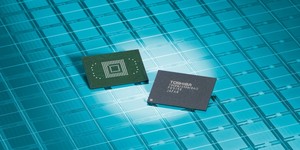
Memory market watcher DRAMeXchange has published a list of predictions which will be welcomed by those planning on upgrading to solid-state storage: things are set to cheaper and faster in the none-too-distant future.
According to the group's research, mass production of latest-process NAND flash in the second half of this year holds the promise of seeing unit costs drop below $1. As a result, the cost of producing high-capacity solid-state storage devices will drop drastically.
This ties in nicely with another of the group's predictions: growing numbers of ultra-portable laptops built to Intel's Ultrabook specifications will mean an explosion in demand. According to DRAMeXchange, the 'mainstream' capacity standard will increase from the current 64GB to 128GB, while increasing numbers of manufacturers will make the jump from spinning-disk or hybrid storage systems to SSDs.
That, coupled with the lower price points, is predicted to drive tripled shipments of solid-state drives in 2012 compared to the previous year. More shipments mean more volume; more volume means that margins can be trimmed to drive down the cost of SSDs still further.
DRAMeXchange also explains that the current move to the SATA 6Gb/s interface standard is a temporary stop-gap system while the SATA-IO working group refines its SATA Express standard. Designed to combine the software infrastructure of SATA connectivity with the electrical transfer interface of PCI Express, the SATA Express standard promises peak transfer rates of up to 16Gb/s compared to the 6Gb/s offered by standard SATA. (Note: that's 2GB/s, not the 2TB/s originally claimed by DRAMeXchange.)
This is key to unlocking the true performance of NAND flash, the group claims. As technologies including the Open NAND Flash Interface (ONFI) 3.0 and toggle DDR2 enter mass production, the bottleneck for transfer speeds will shift from the NAND flash itself to the controller. Without SATA Express, near-future SSDs are likely to rapidly saturate the SATA bus causing an unavoidable performance barrier.
Sadly, it's likely to be a while before we're upgrading to the new standard. SATA Express has yet to be ratified, while DRAMeXchange predicts that commercial implementations won't appear until 2014 at the absolute earliest.
According to the group's research, mass production of latest-process NAND flash in the second half of this year holds the promise of seeing unit costs drop below $1. As a result, the cost of producing high-capacity solid-state storage devices will drop drastically.
This ties in nicely with another of the group's predictions: growing numbers of ultra-portable laptops built to Intel's Ultrabook specifications will mean an explosion in demand. According to DRAMeXchange, the 'mainstream' capacity standard will increase from the current 64GB to 128GB, while increasing numbers of manufacturers will make the jump from spinning-disk or hybrid storage systems to SSDs.
That, coupled with the lower price points, is predicted to drive tripled shipments of solid-state drives in 2012 compared to the previous year. More shipments mean more volume; more volume means that margins can be trimmed to drive down the cost of SSDs still further.
DRAMeXchange also explains that the current move to the SATA 6Gb/s interface standard is a temporary stop-gap system while the SATA-IO working group refines its SATA Express standard. Designed to combine the software infrastructure of SATA connectivity with the electrical transfer interface of PCI Express, the SATA Express standard promises peak transfer rates of up to 16Gb/s compared to the 6Gb/s offered by standard SATA. (Note: that's 2GB/s, not the 2TB/s originally claimed by DRAMeXchange.)
This is key to unlocking the true performance of NAND flash, the group claims. As technologies including the Open NAND Flash Interface (ONFI) 3.0 and toggle DDR2 enter mass production, the bottleneck for transfer speeds will shift from the NAND flash itself to the controller. Without SATA Express, near-future SSDs are likely to rapidly saturate the SATA bus causing an unavoidable performance barrier.
Sadly, it's likely to be a while before we're upgrading to the new standard. SATA Express has yet to be ratified, while DRAMeXchange predicts that commercial implementations won't appear until 2014 at the absolute earliest.

MSI MPG Velox 100R Chassis Review
October 14 2021 | 15:04








Want to comment? Please log in.